The Long Road of Jerry Burns
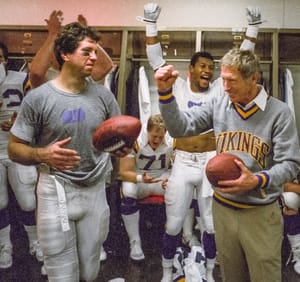
Much has been written about former Vikings coach Jerry Burns, but no one can ever say the man didn’t have patience.
Burns played football at the University of Michigan between 1947-1950, but there’s no record that he ever played a varsity minute.
One of several quarterbacks at Michigan, the Wolverines went to the Rose Bowl twice during Burns’ four years at Michigan. While 44 of his teammates were winning both of those Rose Bowls in sunshiny Pasadena, Calif., the coaching staff told Burns that since he was not on the active roster, he had to pay his own way to Pasadena. If not, well, he could always listen to the game back in Ann Arbor.
The only mention of Burns in Michigan newspapers during his senior year in 1950 was that he was the third-string punter who boomed a long punt in practice.
Wait, I almost forgot: A reporter wrote in the Oct. 22, 1950 edition of the Battle Creek Enquirer that Burns was the fourth-string quarterback behind fellows named Putich, Palmer & Billings. When it came to rewarding the plucky Burns, one wonders if the Michigan coaching staff had dudes named Dewey, Cheatem & Howe.
After graduating from Michigan, the Detroit native eventually landed in Hawaii. There, Burns started his coaching career when he was 24 years old. When he retired forty years later, he had been celebrated, scorned, passed over, fired, appreciated, ignored, teased and loved. He also proved to be loyal to people he valued. Burns coached for the Minnesota Vikings for 24 years; six years as head coach. The Vikings made the playoffs three times during his head coaching tenure, and because he was honest with his players, open with his emotions and fairly successful (52-43 as head coach), he’s on a lot of Mt. Rushmore lists of best Vikings head coaches.
THE NOMADIC YEARS
“Burnsie” as he was affectionately known, began coaching at the University of Hawaii in 1951 as head baseball coach and assistant football coach. Like many professional coaches, he led a Nomad’s life, migrating to California a year later to become Whittier College’s head coach of basketball and assistant football coach. He left California after one year and moved home to Detroit where he assumed head-coaching duties of football and basketball at St. Mary’s of Redford High School. The following year fellow Michigan alumnus, Forest Evashevski, hired Burns as an assistant football coach at the University of Iowa.
Settling in at Iowa in the fall of 1954, Burnsie was 27 years old and on the staff of a Big Ten football team—a great place to be.
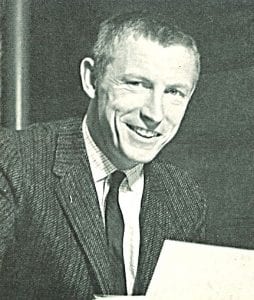
Iowa Hawkeyes Head Coach Jerry Burns in 1962
It became better. Seven years later, Burns was named the head coach of the Hawkeyes.
Before the first game in the 1961 season, the Associated Press ranked Burns’ Iowa team No. 1 in the nation. Burns’ Hawkeyes won their first four games but then did a face plant, losing their next four. In their final game of the year, the Hawkeyes defeated Notre Dame, 42–21. It was Iowa’s fifth win in six years over the Irish. Iowa finished the season 5–4, their last winning record until 1981.
Burns’ other noteworthy accomplishments at Iowa include defeating Michigan and Ohio State in the same year (1962), the only time Iowa accomplished that twin takedown of Big Ten powers. In 1965, Playboy Magazine picked Iowa as their preseason favorite to win the national championship, going so far to predict Iowa would finish 9-1. There were reasons why Playboy didn’t depend on football forecasting to drive sales. Heading into their tenth game, the Hawkeyes were 1-8 and even Aunt Mary knew Burns would be fired after the final game of the 1965 season. Every Iowa and Michigan newspaper carried that news on Tuesday, Nov. 17, 1965.
Three days later, Iowa lost its last game, 28-20 to North Carolina State. When the final gun sounded, Iowa players showed their fans what they thought of their head coach, hoisting their beloved Burnsie on their shoulders and carrying him to the locker room.
As later written by Al Grady, Burns revealed who he was on the day Iowa fired him: “I want to be emphatic. I hold no ill feelings toward anyone. I hope, I sincerely hope, Iowa has great success in football in the future. If I can contribute to that future, I will. If we have failed, and we have, I’ll take the responsibility for that. It is not the players’ fault. They have done the best they can.”
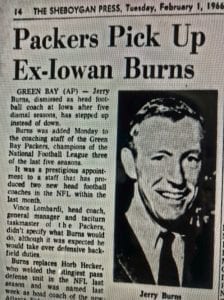
Landing on His Feet
Passed Over Once, Jerry Burns Finally Gets The Top Job
The wiry Burns landed on his feet, joining Vince Lombardi’s Green Bay Packers as defensive backfield coach in 1966 and 1967, both championship years in Green Bay. After hiring Burns, Lombardi sent his new assistant out to speak at banquets on behalf of the Packers. Burns told one Wisconsin audience that although he had been coaching for 17 years, it only took three months with Lombardi for Burns to realize that he really didn’t know anything about football.
When Lombardi stepped down as head coach in Green Bay, Bud Grant poached Burns from the Packers, and he served as Grant’s offensive coordinator for the next 18 years.
After Grant retired at the end of the 1983 season, Burns’ subordinate, Les Steckel was named head coach. If Burnsie burned, he didn’t let on … Initially. Midway through the Season of Steckel nightmare, Steckel told Burns he didn’t want him on the sidelines during games anymore. Burns decided he didn’t want to be on Steckel’s staff anymore either, and Burns quietly resigned.
Grant came out of retirement in 1985 to patch the wound of Steckel’s lost season and he gave Burns a new title of assistant coach/offensive coordinator. Grant re-retired after the 1985 season. Perhaps in an act of atonement, general manager Mike Lynn secretly flew to Jamaica where Burns and his wife were vacationing. Waking Burns by phone, Lynn asked Burns to meet him at the Half Moon Café near Montego Bay.
The offer Jerry Burns had waited for was made and accepted.
Lynn introduced Burns as head coach on Jan. 7, 1986. Burns sidled over to the bank of microphones. Answering a question posed by Minneapolis Star-Tribune columnist Doug Grow, Burnsie admitted the winding trail to the day of his head-coaching hire left him a tad gobsmacked:
“I was surprised when Bud left. I was surprised when Les was hired. I was surprised when Bud came back, and I’m surprised now.”
HOT AND HUMID: Burnsie Busts Out Against the Bucs
Nine months after finally becoming head coach, Burnsie saw his Vikings lose their home opener, 13-10 to Detroit.
The following Sunday, Sept. 14, 1986, they traveled to Tampa Bay to take on the Bucs.
Truth be known, the Vikings had more trouble handling the heat and humidity than they did beating the Bucs, who finished 2-14 that season. The temperature at game time was in the low 90s, and reached the high 90s on the field with the humidity at 97 percent. Substituting often and flying into Tampa Bay ball carriers, the Vikings got through the game using 1,500 pounds of ice and 300 gallons of water.
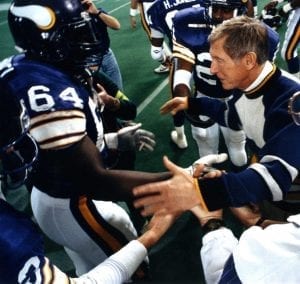
Burns Congratulates Perennial All-Pro Guard Randall McDaniel
Chris Doleman, at the time an outside linebacker, cooled off Tampa Bay in the first quarter, picking off a Steve DeBerg pass intended for running back James Wilder and housing it 59 yards, leaping over DeBerg’s attempted tackle at the Tampa Bay 20. “The quarterback looked at Wilder the whole way,” Doleman said. “He tried to force it in and it glanced off his arm. I knew it was going to him. It was my first touchdown since high school.”
Seventy seconds later, Wilder coughed it up again thanks to a vicious combo tackle by Joey Browner and Scott Studwell at the Tampa Bay 18. That led to Chuck Nelson’s 31-yard field goal. Tampa Bay’s Donald Igwebuike shaved the lead to 10-3 later in the first quarter with a field goal.
The Vikings built their lead to 17-3 early in the second, Tommy Kramer hitting Mike Mularkey with a 10-yard touchdown pass. Big plays on the eight play, 72-yard march were Kramer passes to Darrin Nelson (20 yards) and Allen Rice (26 yards) on successive plays.
Tampa Bay closed the gap with a touchdown with 31 seconds left in the first half; tight end Jimmy Giles scoring on a 1-yard pass from DeBerg.
Chuck Nelson did all the scoring in the second half, pumping through fourth-quarter field goals from 35 and 27 yards. The final was 23-10. Burnsie walked off a winner and his team was 1-1 two games into the 1986 season. “The heat was a factor at the beginning, no question about it,” Burn said. “I think our character showed up. This was a very important game for both teams. Going 0-2 is a lot different from 1-1 or 2-0.”
The Vikings run defense also showed up, holding Tampa Bay to 83 yards, 33 in the second half. “Their defense looked a lot better than it did on film,” said Tampa Bay’s Ron Springs, who was held to 35 yards rushing on 12 attempts. Wilder didn’t fare much better, gaining 48 yards on 18 attempts. DeBerg set a Tampa Bay record with 15 straight completions in an 18-for-28 day, but he threw two interceptions one week after throwing seven in the Buc’s opening loss to the 49ers.
Darrin Nelson and Alfred Anderson gave the Vikings rushing production, Nelson gaining 76 yards on 19 trips and Anderson rushing eight times for 26 yards.
Kramer’s passing performance was good enough—connecting on nine of 21 passes for 130 yards—which gave the Vikings a slight edge in total yards, 242 to 239. More importantly, Jerry Burns walked off the field as a winning head coach in the National Football League.
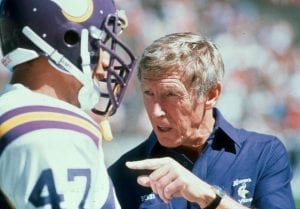
Burns with Vikings All-Pro safety Joey Browner
EXTRA POINTS:
Thank you for reading Part IV of this anthology of first wins by each Vikings head coach. Because of the draft, which begins on Thursday, more timely stories will populate the pages of Purpleptsd.com during draft weekend. I’ll post Part V of this series—Denny Green’s first win—the weekend of May 5-6.
The 1952 Rose Bowl was the first collegiate football game ever broadcast on television.
During five Iowa off-seasons, Burns helped Grant, then coaching Winnipeg in the Canadian Football League (CFL), learn concepts of Iowa’s offense. Grant used a hybrid of the Iowa offense in the CFL and his Blue Bombers benefited by winning four Grey Cups during Grant’s tenure.
Sports Illustrated (SI) did a story on Burns midway through his first season as Vikings head coach. The story revealed that Burns had won over his players: “He’s the best thing that ever happened to this team,” said Keith Millard. Kramer said the Vikings had taken on Burns’ personality, and had become a charged, emotional team. And, added Studwell, “The game is fun again.”
Ahmad Rashad, four years retired in 1986, told SI that “[Burns] is absolutely one of the nicest people you could hope to work with, but he’s tough. Very tough, and a very smart man. The term is used too freely, but Burnsie is really an offensive genius.”
SI’s Bob Kravitz addressed Burnsie’s roundabout path to the head-coaching job: “But when Grant first resigned after the 1983 season. Burns was quite cruelly passed over for the younger, brasher and more vociferous Steckel.
Why the insult? Burns won’t talk about it. Rashad thinks Steckel “outpoliticked” him. Lynn allows that Burns might have been “stereotyped” as an assistant coach. There is a Burns in every office—an efficient, likable good soldier whom everybody acknowledges as utterly invaluable, yet nobody remembers come promotion time.
Whatever the reason for his rejection by the Minnesota management, Burns was hurt. He went so far as to tender his resignation during the 1984 season after Steckel reduced his sideline play-calling responsibilities.”
The Vikings finished Burnsie’s first season as head coach in second place in what was then the NFC Central division with a 9-7 record. The Bears, a year removed from their 1985 Super Bowl win, won the division with a 14-2 record, one of those losses coming to the Vikings, 23-0 in Minnesota. The Lions (5-11), Green Bay (4-12) and Tampa Bay finished behind Minnesota.
Burns was 58 years old when he finally hired as Vikings head coach, the same age as Mike Zimmer when Zimmer took the position 28 years later. As head coach, Burns led the Vikings to the playoffs three times in six years.
His time included a division title in 1989 and a trip to the NFC championship game in 1987.
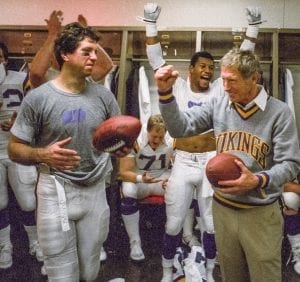
Burns and Vikings Earn Wild Card Road Win in New Orleans
In 1987, the Vikings finished 8-7—replacement players lost all three of their games—but the regular Vikings made the playoffs. After beating New Orleans (the Saints had won nine straight games) on the road in a wild card game, the Vikings shocked the 13-2 49ers at San Francisco, 36-24, but lost at Washington 17-10 in the NFC championship game. Washington won the Super Bowl two weeks later, blasting Denver 42-10.
On November 5, 1989, Burns dropped a gazillion F bombs during a postgame press conference in which he defended his offensive coordinator, Bob Schnelker, who was lustily booed in the Metrodome near the end of regulation in a 23-21 overtime win. Minnesota kicker Rich Karlis provided 21 points via seven field goals, and Mike Merriweather’s block of a punt led to a game-winning safety in overtime. The tirade was not Burnsie’s best moment on the planet, but it did illustrate the ferocity of Burns’ loyalty to his colleagues, especially when they were treated unfairly, a situation with which Burns was familiar.
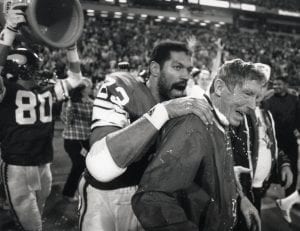
Central Division Champs
On December 4, 1991, Burns announced that he would retire from coaching after the 1991 NFL season; he finished his final season with an 8-8 record. He has been nominated for the Pro Football Hall of Fame, but has yet to gain the votes necessary for induction. In 1998, Burns gave the Hall of Fame induction speech for Paul Krause, a defensive back he coached both at Iowa and with the Vikings.
SOURCES:
Zachary Tarrant – Archive Coordinator Minnesota Vikings
University of Iowa 1962 Hawkeye Yearbook
25 Years With The Fighting Hawkeyes, 1964-1988 by Al Grady
The Battle Creek Inquirer
Minneapolis Star-Tribune
Lansing State Journal
The Sheboygan Press
Sports Illustrated
Playboy Magazine
Associated Press
Profootballreference.com
Wikipedia.com
